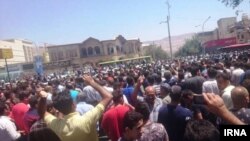The inflation rate in Iran reached 15.9 percent in October, the Central Bank of Iran (CBI) reported one week before the second round of US sanctions that target Iran's international banking and oil export.
The CBI report also says that compared to the rate for the same month in the previous year, the inflation rate has risen by 36.9 percent.
In another development, while economists are warning about a hyperinflation that would soar up to 65 percent, President Hassan Rouhani has ruled out the danger, calling the economists "liars."
He said during a parliamentary session on Saturday while introducing his new ministers that "Those who warn against hyperinflation either lie, or don not understand Iran's economy."
Ironically, his new economy minister Farhad Dejpasand said in his speech at the same session that Iran was facing a hyperinflation. He later tried to "correct" himself in a desperate attempt in a second speech at the session.
The term "hyperinflation" became popular in the Iranian press after an economic publication quoted Steve Hanke, an economics professor in Johns Hopkins University, using the word when he said in the summer of 2018 that he believed the annual inflation rate in Iran is currently at 151 percent.
His estimate for 27 October was even much higher:
"The idea of hyperinflation is based on a wrong economic and political analysis," Rouhani maintained, adding, "Unfortunately we have left single-digit inflation behind, but we can harness inflation, and the jump in the inflation rate will not continue."
" A specter is haunting Iran – the specter of hyperinflation," Iranian economists warned in late June in a statement reminiscent of the communist party manifesto, adding that the rise in inflation rate was at an unprecedented level.
Economic hardship, including unemployment and rising prices have led to repeated mass protests in Iran this year. Any event or unexpected development can suddenly lead to renewed new unrest, as the political and economic situation remains volatile.
In the meantime, the Iranian press warned about the economy getting increasingly similar to Venezuela as it is heading toward an inflation figure between 50 to 65 percent.
Only during the past few months, Iran's inflation rate rose from 11.5% in August to 13.5% in September, before reaching 15.9% in October. During the past month, the point to point inflation rate rose from 31.4% in September to 36.9% in October.
Interestingly, the Iranian Statistical Center, puts the inflation rate for October at 2.1% much less than the figure announced by the Central Bank.
The International Monetary Fund's forecast for Iran by the end of 2018 is an inflation rate of 29.6 percent and an economic growth rate of minus 1.5 percent. Professor Hanke disagrees.
Earlier this year, in response to a question by the Iranian economic magazine Tejarat-e Farda, Hanke had opined that Iran's inflation rate was as 10 to 12 times higher than the official rates announced by Iranian government institutions.
The reason for the vast difference between Hanke's figures and Iranian government's statistics is that he used the market rate for US dollars in his calculations, while the Iranian government's figures are based on a much lower rate determined by the government, but applicable to a select group of goods, not to the whole economy.
“Hanke's statistics are more accurate, because most of the goods in Iran are imported from abroad and are therefore influenced by the exchange rate. Exchange rates even affects non-commercial goods such as taxi fares. Therefore, the exchange rate index is more accurate to assess the inflation rate." Mohammad Gholi Yousefi, professor of economics at Allameh Tabataba'i University was quoted by Persia Digest as saying.
A study by the Iranian Parliament's research center indicates that every ten percent rise in the rate of exchange for US dollar in Iran adds another two percent to the inflation rate. The currency has declined five-fold in 2018; giving an indication of what the real inflation rate is.
The rise in inflation is best reflected in the cost of living in Iran. According to Omid Ali Parsa, the chairman of Iran's statistical center, the rise in average housing cost in October has been 34 percent.
